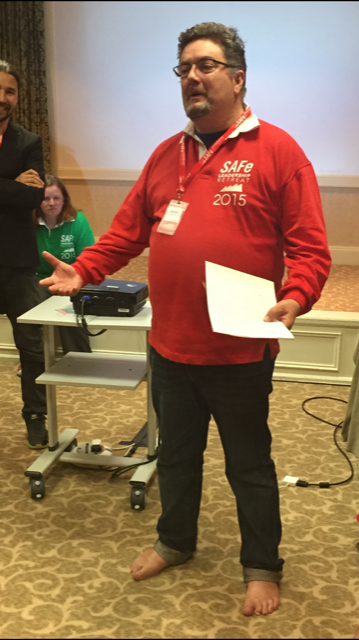Gitte recently recommended this fantastic must-read article on Cameratas by Jessica Kerr. My only criticism is this statement:
One camerata emerged inside ThoughtWorks (consultancy) in London around 2003–2006. This group gave us Continuous Integration, Continuous Delivery, DevOps. They weren’t all on the same project, but they talked to each other, and they solved the problem of: Does deployment have to be so hard?
Jez and Dan and Chris Read produced The Deployment Production Line. Later, Dan went to invent BDD, Sam Newman became a prophet of microservices, and more. I keep meeting conference speakers who were part of this group.
The Camerata in London was not centred on ThoughtWorks, it was centered on The Extreme Tuesday Club. In fact, ThoughtWorks was one of several companies that played host to a chunk of the Extreme Tuesday Club, others being Connextra, BNP Paribas, Google, UBS, Sky, Springer and Zuhlke.
The Old Bank of England was the second or third regular meeting place for XTC. It was the first place where I attended.
Why Extreme Tuesday Club?
The Extreme Tuesday Club was one of many Local Agile Communities that existed in the early naughties. Other notable communities were The Salt Lake City Round Table (Todd Little, Alistair Cockburn, Jeff Patton), The Silicon Valley Patterns Group (Rus Rufer, Tracey Bailik, Joshua Kerievsky, Mike Hill), The Portland Patterns group (Ward Cunningham, Diana Larsen) and many others. Members of these local communities were networked thanks to the OOPSLA conference.
In 2003, the Salt Lake City Round Table organised the first Agile Development Conference which went on to merge with XP/Agile Universe and become the Agile20xx conference. In 2004, the second Agile Development Conference was organised by members of the Extreme Tuesday Club, namely Rachel Davies, Andy Pols, John Daniels and Steve Freeman, of whom only Steve ever worked for ThoughtWorks.
I was the only employee of ThoughWorks London to attend in 2003. Partly as a result of the write up of my experience, in 2004, about seventeen employees of ThoughtWorks London attended, and we had a ThoughtWorks stand. This launched ThoughtWorks London on the Global Agile Stage as the group made a major impact on the conference.
Like the other communities, the combined impact on Agile of members of the Extreme Tuesday Club has been quite significant. I will list a few below. Many of those members worked for ThoughtWorks for a period of time. However, it is the Extreme Tuesday Club that provided the community that generated the ideas.
The Extreme Tuesday Club had weekly feedback loops. People would suggest an idea one Tuesday, a week later they would get feedback. XTC was a hub. Visitors from outside London would head to XTC and the global network was strengthened. Famous visitors would also attract new members. XTC organised XP Day which was the only place in London to learn about XP/Agile for many years. Mainly, XTC was a friendly face and a empathetic ear for those trying to make XP/Agile work in their work lives.
Why ThoughtWorks?
ThoughtWorks was hiring people with experience of eXtreme Programming at a time that no one else was. Paul Hammant actively recruited people from the Extreme Tuesday Club into ThoughtWorks. Hence there was a very large overlap between the Extreme Tuesday Club and ThoughtWorks. I am eternally grateful to Paul for being one of the people he recruited from XTC.
ThoughtWorks was great. It was on the bench that Dan North explained BDD to me ( c/Assert/Should ) which made it much easier to coach people to adopt TDD. “Should” provided me a link between Business Analysis and Agile Development. I then introduced “GIVEN” to express mocks. Dan and I then collaborated to come up with the “WHEN” and replace “SHOULD” with “THEN” to complete the trio. This was only possible because of ThoughtWorks positive attitude to supporting innovation in the Agile Space. ThoughtWorks left us to work on things we considered valuable rather than find busy work for us.
I left ThoughtWorks shortly afterwards in 2004, continuing to develop Real Options, Feature Injection (which includes GWT), Kanban, Capacity Planning, Skill Liquidity, Tech Debt in collaboration with members of XTC and the wider network of communities. When people left TW, many remained together as a community as part of XTC. Sometimes, XTC members would help people find jobs when they left TW unexpectedly.
Why ThoughtWorks rather than Extreme Tuesday Club
XTC is only something that you will hear of if you are connected to an existing member or visitor.
Why do so many people think that the London Software Camerata centres around ThoughtWorks rather than Extreme Tuesday Club? The answer is simple… Martin Fowler, Dan North and Jez Humble are more famous than the Extreme Tuesday Club.
Within ThoughtWorks, like all consultancies, they promote their own and play down the role of others. Within ThoughtWorks, you are more likely to hear about the contributions of ThoughtWorkers that the shoulders of giants that they stand upon. Martin Fowler has 250K+ followers on twitter. He is brilliant. His job is to promote ThoughtWorks and he does it well.
So people see Dan and Jez and other famous ThoughtWorkers rather than the XTC.
The London Software Camerata
XTC is an important part of Agile History. It would be great if we tried to document that history, especially showing the collaborations between members.
Years ago I tried to list the contributions of XTC members to Agile. I gave up after about listing fifty people. I just want to give you a taste (Please add a comment with people I have left out):
- Rachel Davies
- Tim MacKinnon*
- Ivan Moore*
- Andy Pols
- John Nolan
- Nat Pryce*
- Ade Oshineye*
- Joe Walnes*
- Liz Keogh*
- Gabrielle Benefield
- Robert Benefield
- Benjamin Mitchell
- Portia Tung
- Keith Braithwaite
- Mike Hill*
- Richard Watts*
- Paul Simmons
- Tom Ayerst
- Antony Marcano
- Andy Palmer*
- Giovanni Gasproni*
- Douglas Squirrel
- Marc Johnson*
- Gojko Adzic
- David Evans
* – Indicates they worked for ThoughtWorks at some point.


